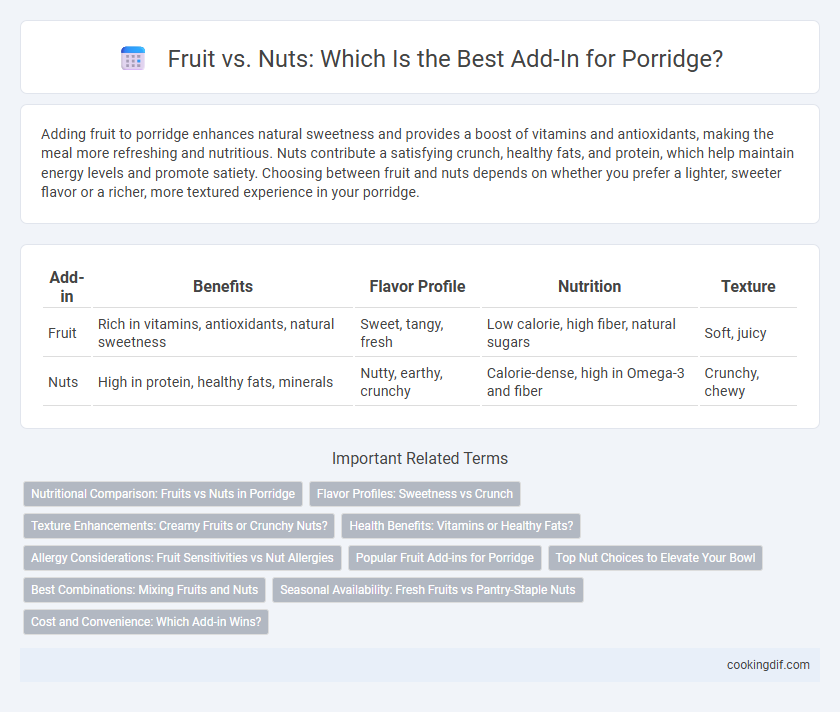Adding fruit to porridge enhances natural sweetness and provides a boost of vitamins and antioxidants, making the meal more refreshing and nutritious. Nuts contribute a satisfying crunch, healthy fats, and protein, which help maintain energy levels and promote satiety. Choosing between fruit and nuts depends on whether you prefer a lighter, sweeter flavor or a richer, more textured experience in your porridge.
Table of Comparison
| Add-in | Benefits | Flavor Profile | Nutrition | Texture |
|---|---|---|---|---|
| Fruit | Rich in vitamins, antioxidants, natural sweetness | Sweet, tangy, fresh | Low calorie, high fiber, natural sugars | Soft, juicy |
| Nuts | High in protein, healthy fats, minerals | Nutty, earthy, crunchy | Calorie-dense, high in Omega-3 and fiber | Crunchy, chewy |
Nutritional Comparison: Fruits vs Nuts in Porridge
Fruits in porridge provide natural sugars, fiber, and essential vitamins such as vitamin C and antioxidants, promoting digestive health and immune support. Nuts contribute healthy fats, protein, and important minerals like magnesium and zinc, enhancing satiety and supporting muscle function. Balancing fruits and nuts in porridge enriches its nutritional profile by combining quick energy with sustained fullness and diverse micronutrients.
Flavor Profiles: Sweetness vs Crunch
Fruit adds a natural sweetness and a juicy texture to porridge, enhancing the overall flavor with fresh, vibrant notes. Nuts contribute a satisfying crunch and a rich, earthy taste that balances the porridge's creaminess. Combining fruit and nuts creates a dynamic contrast between sweet and crunchy elements, elevating the sensory experience of each spoonful.
Texture Enhancements: Creamy Fruits or Crunchy Nuts?
Creamy fruits like bananas and berries add smoothness and moisture to porridge, enhancing its softness and providing natural sweetness. Crunchy nuts such as almonds, walnuts, and pecans contribute a satisfying crisp texture while boosting protein and healthy fat content. Combining both fruits and nuts creates a balanced contrast, enriching the porridge with diverse mouthfeel and complexity.
Health Benefits: Vitamins or Healthy Fats?
Fruit adds valuable vitamins such as vitamin C and antioxidants to porridge, boosting immune health and reducing inflammation. Nuts contribute healthy fats like omega-3 fatty acids, supporting heart health and improved brain function. Combining fruits and nuts enhances porridge with a balanced mix of essential nutrients for overall wellness.
Allergy Considerations: Fruit Sensitivities vs Nut Allergies
Fruit add-ins in porridge often pose fewer allergy risks compared to nuts, which are common allergens known to cause severe reactions like anaphylaxis. Individuals with nut allergies must avoid nuts entirely, while fruit sensitivities typically result in milder symptoms such as digestive discomfort or oral irritation. Choosing fruit over nuts reduces the risk of life-threatening allergic responses, making porridge safer for a broader range of dietary needs.
Popular Fruit Add-ins for Porridge
Popular fruit add-ins for porridge include berries such as blueberries, strawberries, and raspberries, which provide antioxidants and natural sweetness. Bananas and apples are also favored for their texture and fiber content, enhancing both taste and nutritional value. Dried fruits like raisins and apricots add chewiness and concentrated flavors without extra sugar.
Top Nut Choices to Elevate Your Bowl
Top nut choices to elevate your porridge bowl include almonds, walnuts, and pecans, each providing a rich source of healthy fats, protein, and essential vitamins. These nuts enhance texture and add a satisfying crunch while boosting the dish's nutritional profile with antioxidants and omega-3 fatty acids. Incorporating nuts as add-ins supports prolonged energy release and improves heart health, making them a superior option compared to many fruits.
Best Combinations: Mixing Fruits and Nuts
Combining fresh fruits like berries or sliced bananas with crunchy nuts such as almonds or walnuts enhances porridge both nutritionally and texturally, providing a balanced mix of vitamins, fiber, and healthy fats. The natural sweetness of fruits complements the nutty richness, creating a satisfying and flavorful breakfast option. Mixing dried fruits like raisins or cranberries with roasted nuts also offers a concentrated burst of natural sugars and antioxidants, perfect for a hearty morning meal.
Seasonal Availability: Fresh Fruits vs Pantry-Staple Nuts
Fresh fruits for porridge vary seasonally, offering vibrant flavors and essential vitamins during their peak times, such as berries in summer and apples in autumn. Nuts, as pantry staples like almonds, walnuts, and pecans, provide consistent availability year-round, contributing healthy fats and protein without concern for seasonal limitations. Choosing between fresh fruits and nuts depends on whether one prioritizes seasonal freshness and nutrients or convenience and long-lasting storage.
Cost and Convenience: Which Add-in Wins?
Nuts typically have a higher price point than most fruits, making fruits the more budget-friendly add-in for porridge. Convenience-wise, fruits often require minimal preparation and can be added fresh or frozen, while nuts sometimes need chopping or roasting for enhanced flavor. Cost-efficient and easy-to-use fruits generally win when balancing affordability and simplicity in porridge add-ins.
Fruit vs Nuts for add-ins Infographic

 cookingdif.com
cookingdif.com